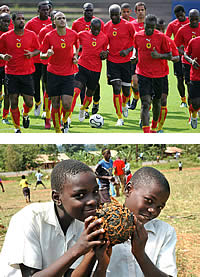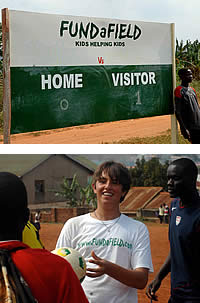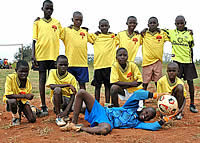
by Danielle Hensley, 13, Naomi Farahan, 13, and Shanze Tahir, 12
Y-Press, Inc.
 Professional soccer’s top competition will be played in South Africa this summer, and the country is buzzing with excitement. Not only will it be the first time the Federation of International Football Association will stage the FIFA World Cup on African soil, but it also recognizes soccer’s importance to this historic land and its youth.
Professional soccer’s top competition will be played in South Africa this summer, and the country is buzzing with excitement. Not only will it be the first time the Federation of International Football Association will stage the FIFA World Cup on African soil, but it also recognizes soccer’s importance to this historic land and its youth.
“It’s more like a religion,” explained Kyle Weiss, 17-year-old founder of FUNDaFIELD, a nonprofit organization dedicated to enriching the lives of African youth through soccer.
Kyle and his brother, Garrett, 19, started FUNDaFIELD in 2006 while they were both students in Danville, Calif. They were attending the Iran-Angola World Cup competition in Leipzig, Germany, and started talking to some Angola fans. “They were some of the craziest soccer fans I’ve ever seen. They were hanging over the walls, drumming, just singing the whole time,” Kyle recalled. “They told us about how Angola has been in this long civil war and they had just gotten out of it and how soccer was just the biggest thing in Angola and nothing could compare to it.”
The fans also told the brothers that most youth in Africa lacked even the most basic equipment needed to play soccer, often using homemade balls.
When the brothers returned home, they talked to some of their friends and devised a plan to not only donate equipment, but also to build soccer fields in Africa. But first, they needed to raise money. Each student agreed to hold two fundraisers a year.
Three years later, FUNDaFIELD has raised more than $100,000. The founding “team” has grown from a handful of friends to more than 30 members—all middle and high school students—each using their own ideas to raise money. It also has fundraisers on its Web site as well as items to purchase to benefit the organization.
In 2008, FUNDaFIELD had raised enough money ($18,000) to build its first field. Though the brothers were hoping to build in Angola, the country was too unstable, so they went to South Africa instead. They began e-mailing civic and nonprofit groups in hopes of finding partners and possible sites and heard back from Saul Garlick of the nonprofit Think Impact in South Africa.
That organization, which built schools and water facilities, helped FUNDaFIELD settle on two rural areas where it also was working— Mdluli and Manyangana high schools in rural South Africa.
Challenges and rewards
There are many challenges to building soccer fields, which range in cost from $10,000 to $25,000, depending on the amount of work to be done. It starts with clearing and leveling the land and ends with installing bleachers and scoreboards. “The area around the field, we make sure it’s clean and it’s a proper soccer field instead of just trash everywhere, which is a big problem in Africa,” Kyle said.
But those are among the easier tasks. Problems with communication and expectations almost always complicate the situation.
“On the Africa side, you’ll see that nothing ever happens according to plan,” Kyle added.
After construction, which usually involves members of the community in some capacity, FUNDaFIELD provides equipment, such as balls, cleats and uniforms, and arranges a soccer tournament for the village’s children. The members usually consider this to be the best part of the process.
“You’ll never see a more proud group of people than a community after they’ve helped build and are playing on their very own soccer field,” Kyle said.
Building community
Jake Becker has been with FUNDaFIELD since its early days. He played soccer with Kyle for most of his life and was one of 10 organizers who paid their own way to go to the Mdluli site, in the village of Hluvukani.
He explained that after he arrived in Mdluli—in keeping with FUNDaFIELD tradition—there was a soccer tournament at the new field. Around 500 students played, and about 2,000 people came to watch. “They said it was the biggest event that has happened or will happen in their lifetime,” Jake noted.
 Since then, FUNDaFIELD has built two fields in Uganda and two in Kenya. This year they hope to build at least five more fields, including another one in Uganda.
Since then, FUNDaFIELD has built two fields in Uganda and two in Kenya. This year they hope to build at least five more fields, including another one in Uganda.
Kyle and Jake believe that soccer not only teaches teamwork and enhances physical ability, but also brings people together.
“As a lot of people say, ‘Our town, our village, it has no center. There’s no place where we can all go meet.’ The soccer field creates a sense of community. It brings everybody in the town together,” Kyle said.
But perhaps more importantly, the soccer fields give youth a break from the poverty and hardship of their lives.
“Some of the kids had skin diseases,” said Jake. “Many of them talked [about] how family members had AIDS, how they were worried about death. And they said soccer is something that gets them away from all those challenges in the community.”




